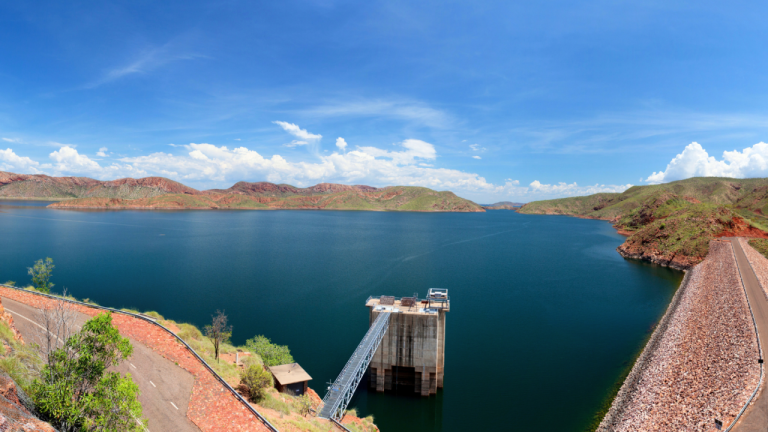Water infrastructure and decarbonising industry
Northern Australia – from the Kimberley and Pilbara to the Top End – represents one of the nation’s greatest opportunities, and one of its most enduring challenges.
Northern Australia – spanning northern Western Australia and the Northern Territory – holds significant untapped potential, with its extensive natural resource deposits, strong prospects for large-scale renewable energy development, proximity to key Asian markets, vast areas of undeveloped land, and rich Aboriginal culture and heritage.
Over recent years, our Marsden Jacob team has partnered with governments, industry and Traditional Owner organisations to support the region’s long-term development. Spanning water, agriculture, energy and mining sectors, our work has contributed to a range of regional development priorities – each aimed at strengthening the foundations for sustainable and inclusive growth across the north.
In part one of this two-part series, Kanchana Karunaratna and James Holloway explore two of these regional development priorities: reliable water infrastructure and decarbonising industry and powering the ‘green’ economy.
Priority 1: Water infrastructure to unlock regional growth
Reliable water infrastructure is critical to enabling the next wave of regional growth in northern Australia. While challenges vary across regions, two persistent barriers remain: unlocking access to existing water resources and securing new, climate-resilient supply to meet future demand.

Distribution challenges in the Kimberley
In the Kimberley, abundant water stored in Lake Argyle contrasts sharply with the infrastructure needed to move it. The existing delivery system was not designed to service all farms at once, which worked effectively when crop diversity naturally staggered demand. However, the growing dominance of cotton – with its tight planting window – is intensifying peak demand and placing greater strain on the system. Expanding the Ord Irrigation Area further within Western Australia and into the Northern Territory will require significant investment to ensure the system can meet changing demand patterns and support irrigable land development across jurisdictions.
Meeting future demand in the Pilbara
Whereas the Kimberley’s challenge lies in distribution, the Pilbara is constrained by limited long-term supply – with groundwater systems under growing stress, there is a need to balance environmental and commercial outcomes. Meeting future demand – including from mining, green industries, and growing town water needs – will require a shift to climate-independent supply options that strike a balance between environmental and commercial outcomes, supported by coordinated investment in renewable energy.
Our team has supported efforts to overcome these infrastructure constraints and plan for long-term regional water needs:
- Ord River Irrigation Area Expansion – Preliminary and Detailed Business Cases – NT Government (2023-present)
We assessed infrastructure options to transport water from Lake Argyle to new agricultural precincts in the NT and for future expansion within WA as per the DPIRD ORD Strategy, including connection strategies and delivery system upgrades. The work represents a first-of-its-kind effort to operationalise cross-border water transfer in WA – a complex undertaking that breaks new ground in interjurisdictional infrastructure planning.
- Ord River Irrigation Area (ORIA) Industry Needs Assessment – DPIRD (2024)
We conducted a strategic assessment to identify barriers to farm-level viability and constraints to regional expansion in the ORIA. Our work identified infrastructure limitations and inefficiencies in the water delivery system that are constraining productivity and limiting the area’s potential for expansion.
Our team provided economic and strategic advisory services to support the development of a large-scale desalination project in the Pilbara. This project has the potential to play a critical role in reducing reliance on increasingly constrained groundwater sources and securing affordable, climate-resilient water for current and future industries.
Priority 2: Decarbonising industry and powering the ‘green’ economy

Emissions reduction in the Pilbara
The Pilbara plays a critical role in Australia’s emissions profile and future clean energy opportunity. It is home to some of the country’s most emissions-intensive industries and contributes nearly a quarter of all emissions covered under the Safeguard Mechanism. At the same time, the region has some of the highest solar irradiance levels in the world and complementary wind resources – making it one of the most prospective regions for renewable energy generation globally.
A global hub for green industries
Unlocking this potential is not just about reducing emissions – it’s about establishing northern Australia as a global hub for green industries in hydrogen, green ammonia, and minerals processing. However, achieving this transition requires coordinated infrastructure investment and planning – particularly in energy and water – to avoid duplication and to unlock shared benefits.
Firming reliable supply
It also requires a clear-eyed understanding of the operational needs of industry. Renewable energy sources such as wind and solar are inherently variable, meaning reliable supply must be supported by firm or dispatchable capacity – whether through storage, flexible generation or demand management. Planning for this balance is critical to ensuring energy remains available when and where it’s needed to power continuous, large-scale industrial operations.
We have focused on enabling large-scale decarbonisation and supporting the foundations of a clean, export-oriented energy economy:
- Common-User Transmission Infrastructure (CUTI) for the Pilbara – CEFC (2024–25)
We evaluated how shared transmission infrastructure could accelerate the Pilbara’s energy transition by improving system efficiency, reducing duplication, and lowering costs for renewable energy users. The work highlighted the importance of coordinated investment to unlock large-scale renewables and enable the region to decarbonise more rapidly and economically than under a fragmented, project-by-project approach.
- Ngarluma Water Project – Energy Cost Benchmarking and Strategy (2024–present)
As part of our broader role on the Ngarluma Water Project, we are supporting the development of an energy supply strategy for the proposed large-scale desalination plant. This includes evaluating procurement options that combine renewable energy with firming solutions to deliver reliable supply aligned with the plant’s operational needs.
Importantly, the desalination plant will support the growth of future green industries in the Pilbara by providing climate-independent water supply to emerging sectors such as hydrogen, ammonia, and low-emissions iron production. As a large off-taker, the plant can also help underpin investment in renewable transmission infrastructure – further supporting decarbonisation in the region and delivering shared regional benefits.
In Part 2 of this article, we discuss three more key regional development priorities – workforce challenges and regional liveability, planning for remoteness and regional climate risk, and supporting first nations empowerment and leadership – and explore practical, future-focused solutions that support sustainable growth and development across this unique region.
Contact Kanchana Karunaratna, James Holloway , Grant Draper, Alexander Marsden, Kate Riddell or Ram Chandrasekaran to learn more: https://www.marsdenjacob.com.au/people/


